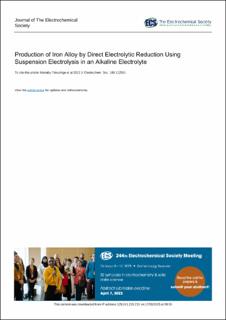| dc.contributor.author | Tokushige, Manabu | |
| dc.contributor.author | Kongstein, Ole Edvard | |
| dc.contributor.author | Haarberg, Geir Martin | |
| dc.date.accessioned | 2023-02-20T15:24:07Z | |
| dc.date.available | 2023-02-20T15:24:07Z | |
| dc.date.created | 2022-12-05T08:25:52Z | |
| dc.date.issued | 2022 | |
| dc.identifier.issn | 0013-4651 | |
| dc.identifier.uri | https://hdl.handle.net/11250/3052477 | |
| dc.description.abstract | Iron alloys were produced by suspension electrolysis in a 50 wt% NaOH–H2O electrolyte at 383 K, and Fe–Cr and Fe–Ni alloys were obtained using a suspension of Fe2O3+Cr2O3 and Fe2O3+Ni(OH)2 particles, respectively. Highly ordered columnar deposits comprising cubic Fe–Cr particles with approximately 5-micrometer-long sides were obtained on a disk cathode with a current efficiency higher than 90% at 100–300 mA・cm−2. In contrast, disordered columnar deposits of Fe–Ni particles with diameters of approximately 1.0 μm were obtained on a disk cathode with a current efficiency of approximately 50% at 200 mA・cm−2. The proposed method affords iron alloys with compositions in the stainless-steel region that depend on the electrolysis conditions, namely, the current density and Fe2O3/Cr2O3 or Fe2O3/Ni(OH)2 content ratio. | |
| dc.language.iso | eng | en_US |
| dc.publisher | IOP Publishing | en_US |
| dc.title | Production of Iron Alloy by Direct Electrolytic Reduction Using Suspension Electrolysis in an Alkaline Electrolyte | en_US |
| dc.title.alternative | Production of Iron Alloy by Direct Electrolytic Reduction Using Suspension Electrolysis in an Alkaline Electrolyte | en_US |
| dc.type | Peer reviewed | en_US |
| dc.type | Journal article | en_US |
| dc.description.version | publishedVersion | |
| dc.source.volume | 169 | en_US |
| dc.source.journal | Journal of the Electrochemical Society | en_US |
| dc.source.issue | 11 | en_US |
| dc.identifier.doi | 10.1149/1945-7111/ac9b97 | |
| dc.identifier.cristin | 2088379 | |
| cristin.ispublished | true | |
| cristin.fulltext | original | |
| cristin.qualitycode | 2 | |
